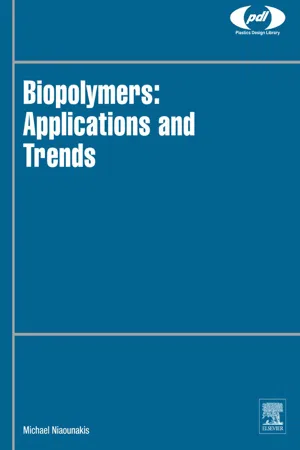
- 604 pages
- English
- ePUB (mobile friendly)
- Available on iOS & Android
Biopolymers: Applications and Trends
About this book
Biopolymers: Applications and Trends provides an up-to-date summary of the varying market applications of biopolymers characterized by biodegradability and sustainability. It includes tables with the commercial names and properties of each biopolymer family, along with biopolymers for each marketing segment, not only presenting all the major market players, but also highlighting trends and new developments in products.The book includes a thorough breakdown of the vast range of application areas, including medical and pharmaceutical, packaging, construction, automotive, and many more, giving engineers critical materials information in an area which has traditionally been more limited than conventional polymers.In addition, the book uses recent patent information to convey the latest applications and techniques in the area, thus further illustrating the rapid pace of development and need for intellectual property for companies working on new and innovative products.- Provides an up-to-date summary of the varying market applications of biopolymers characterized by biodegradability and sustainability- Includes tables with the commercial names and properties of each biopolymer family, along with biopolymers for each marketing segment- Presents a thorough breakdown of the vast range of application areas, including medical and pharmaceutical, packaging, construction, automotive, and many more- Uses recent patent information to convey the latest applications and techniques in the area, thus further illustrating the rapid pace of development and need for intellectual property
Frequently asked questions
- Essential is ideal for learners and professionals who enjoy exploring a wide range of subjects. Access the Essential Library with 800,000+ trusted titles and best-sellers across business, personal growth, and the humanities. Includes unlimited reading time and Standard Read Aloud voice.
- Complete: Perfect for advanced learners and researchers needing full, unrestricted access. Unlock 1.4M+ books across hundreds of subjects, including academic and specialized titles. The Complete Plan also includes advanced features like Premium Read Aloud and Research Assistant.
Please note we cannot support devices running on iOS 13 and Android 7 or earlier. Learn more about using the app.
Information
Definitions of Terms and Types of Biopolymers
Abstract
Keywords
Biodegradable polymers; Bio-based polymers; Polyesters; Polycarbonates; Polyamides; Polysaccharides; Poly(ortho esters); Polyphosphazenes; Sources; Vinyl polymers1.1. General
1.2. Definition of Terms
Table of contents
- Cover image
- Title page
- Table of Contents
- Series Page
- Copyright
- Foreword
- Abbreviations of Biopolymers
- 1. Definitions of Terms and Types of Biopolymers
- 2. Properties
- 3. Packaging
- 4. Agriculture/Forestry/Fishery
- 5. Electronics
- 6. Automotive Applications
- 7. Medical, Dental, and Pharmaceutical Applications
- 8. Cosmetics
- 9. Sports/Toys/Board Games
- 10. Building and Construction Applications
- Glossary
- Index
- Index of Companies
- Index of Inventors
- Index of Patents